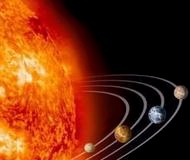
|
|||
| Contents | Prev | Next | |
![]()
9. The Size and Nature of the Second Sun
| Supernova Explosion | |
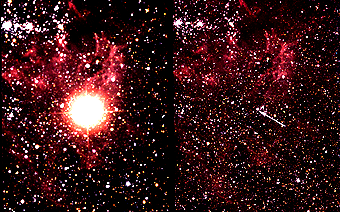 |
|
| After Explosion | Before Explosion |
| imagine.gsfc.nasa.gov | |
The current star theories divide stars into two categories: white dwarf stars and neutron stars. 90% of stars in space are categorized as white dwarfs. The remaining 10% are neutron stars that explode as supernova. The supernova explosion is so huge to the point that you can see it very clearly even with the naked eye. Based on these two categories, we conclude that no solid material whatsoever can be found in dead stars. A nuclear explosion in the size of supernova will not even leave a grain of dust to remain intact. And white dwarfs are only condensed gases that fade away over time. However, on the link below dead stars were found polluted with rocks and metals.
"NASA's Hubble Space Telescope Finds Dead Stars
'Polluted with Planet Debris"
nasa.gov
There are two theories to explain the supposed "planet debris", the link above talks about the leading theory; it states that nearby planets push rocky bodies toward the stars, and then these rocky bodies start orbiting the dying stars.
The other, recently suggested, theory says that the planet debris is the leftover from planets that the stars have destroyed:
"Theory suggests source of white dwarf
pollution… A decades-old space mystery is how the metals came to be in white
dwarf atmospheres. And now an international team of astronomers led by Professor
Martin Barstow of the University of Leicester in the U.K. say they have solved
the mystery. Their solution points to an ominous fate for planet Earth.
Professor Barstow said in a press release: The mystery of the
composition of these stars is a problem we have been trying to solve for more
than 20 years. It is exciting to realize that they are swallowing up the
leftovers from planetary systems, perhaps like our own."
earthsky.org
It is a matter of interpretations; dying stars found polluted with rocks and metals; that is all. No one has seen nearby planets pushing materials toward the stars, or has seen the stars destroying nearby planets.
The natural explanation is to say that the supposed planet debris have actually come out of the original stars after they have broken apart. It is like seeing a collapsed building; you don't need anyone to tell you that the junk you are seeing is the materials that were making up the building. But if you limit your conclusion to two options, then you have to pick one of these two options only, even if the selected option doesn't make sense at all. Saying so however doesn't mean no stars end up their life as condensed gases that vanish slowly over time, but to limit all stars in space to two categories only is a problem.
It seems that the second sun is very similar to, if not the same as, these dead stars that are found polluted with the so-called planetary debris; and of course, the source of the debris is the dead stars themselves, manufactured by the stars in the phase of manufacturing metal and other chemical elements.
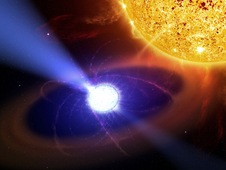
The Sun of the solar system is classified as a star that will end up as a white dwarf. Based on this theoretical classification, it is supposed to vanish without doing anything at all. Now this assumption is challenged. A star that has been classified as a white dwarf was found acting like a pulsing star:
"New observations from Suzaku, a joint Japanese Aerospace Exploration Agency (JAXA) and NASA X-ray observatory, have challenged scientists’ conventional understanding of white dwarfs. Observers had believed white dwarfs were inert stellar corpses that slowly cool and fade away, but the new data tell a completely different story. At least one white dwarf, known as AE Aquarii, emits pulses of high-energy (hard) X-rays as it whirls around on its axis. 'We’re seeing behavior like the pulsar in the Crab Nebula, but we’re seeing it in a white dwarf,' says Koji Mukai of NASA Goddard Space Flight Center in Greenbelt, Md. The Crab Nebula is the shattered remnant of a massive star that ended its life in a supernova explosion. This is the first time such pulsar-like behavior has ever been observed in a white dwarf." (nasa.gov)
Based on the quote above, we assume that the second sun acted as a pulsar by the end of its life, producing gamma rays, not just x-rays.
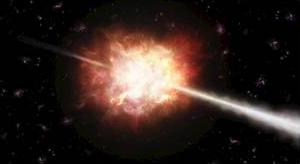
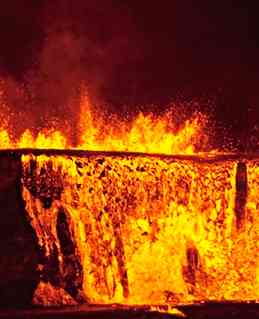
science.nasa.gov
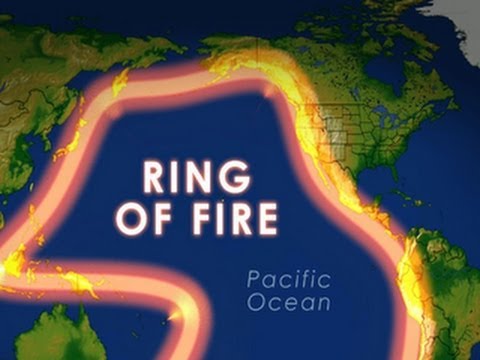
Gamma ray is very penetrating. Even machine-made gamma ray can penetrate, for a certain degree, through lead.
When gamma rays pass through matter, they eject electrons from the atoms they strike. This process is called ionization. It is an action-reaction chemical process that can create new substances and compounds, which can lead to an increase in volume and/or pressure.
The ionization process that have taken place inside the mantle, when the earth was struck with gamma rays, caused a great increase in gas pressure, inside the mantle, that led the mantle to explode and the crust to break, in order to release the extra gas pressure.
The explosions that have taken place inside the mantle created very big holes and trenches in the crust.. Based on debris from the earth's mantle found on the surface of earth, which is exactly the same as volcanic debris, scientists think the Earth was engulfed in widespread volcanism during the mass extinction 200 MYA.
Via the open areas and trenches in the Earth's crust, asteroids and meteoroids from the second sun have gone into the earth's mantle, caused the earth to expand, and mountains to rise.. The rocks that have fallen inside the mantle got melted and created the ocean floor, whereas the rocks that have stacked up created mountains.. Because the ring of fire area contains the oldest ocean floor, it is most likely the first area to explode and open.
![]()
| The full report in a single page | ||
| Contents | Prev | Next |
